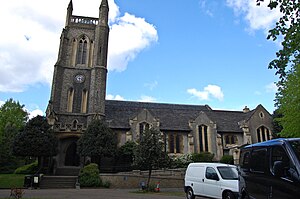Leytonstone
| Leytonstone | |
| Essex | |
|---|---|
| Location | |
| Grid reference: | TQ3987 |
| Location: | 51°34’8"N, 0°-0’36"E |
| Data | |
| Post town: | London |
| Postcode: | E11, E15 |
| Dialling code: | 020 |
| Local Government | |
| Council: | Waltham Forest |
| Parliamentary constituency: |
Leyton and Wanstead |
Leytonstone is a town in Essex, within the north-eastern part of the metropolitan conurbation. It is a suburban area with much green space about notwithstanding that its neighbouring towns are uncomfortably contiguous or nearly so. Leytonstone borders Walthamstow to the northwest, Wanstead to the north, Leyton to the south, and Forest Gate to the east.
Contents
History
The main thoroughfare in Leytonstone, High Road Leytonstone, which runs the length of Leytonstone to Stratford is an ancient pathway dating to pre-Roman times. Roman archaeological features have been found in the area.
The name Leytonstone appears in early documents Leyton-Atte-Stone ("Leyton at the Stone"). This may derive from the large stone standing at the junction of Hollybush Hill and New Wanstead; in the 18th-century an obelisk was mounted on top of it, and it has been claimed that it is the remains of a Roman milestone.
Two of the obelisk's inscriptions are still just legible: others are not.
- "To Epping XI Miles through Woodford, Loughton"
- "To Ongar XV Miles through Woodford Bridge, Chigwell, Abridge"
It has been claimed that High Road Leytonstone is a prehistoric pathway dating from before the Romans built a road along the same route to London. However, there is no evidence for this fancy.. It is sure though that a Roman road was driven through here; traces of Roman roads have since been found during excavations.
The earliest known cartographic reference to Leytonstone as such is dated from 1545.
Leytonstone was the centre of protests against the construction of the M11 link road, in 1990. The protesters' final stand was staged at Claremont Road, Leytonstone and was ended by the forced eviction of protestors in 1994. The road was built (and Leytonstone's traffic problems calmed more than somewhat).
Transport
Leytonstone High Road was a Roman track from London to Epping Forest. This route became important for long distant coaches from the 14th century. In the 1960s there was a problem of congestion around the shopping streets in Leytonstone,[1] a problem which continues with the one way system today.[2]
In the 1990s the M11 link road was built through the area despite a long running protest by locals and road protestors. This and other protests led to the Conservative policy, Roads for Prosperity, being abandoned.[3]
Leytonstone tube station is on the Central Line of the London Underground.
Leytonstone High Road is a London Overground railway station.
Sights about the town
- Epping Forest boundaries reach Leytonstone in wooded areas called Hollow Ponds and Wanstead Flats.
- Whipps Cross University Hospital
- Dagenham & Redbridge football club, currently a professional team, is an amalgamation of several amateur football clubs, including Leytonstone FC, who played along Leytonstone High Road. The Wanderers FC also originated from Leytonstone but played in several other venues.
In drama, film and television
- In The Bed-Sitting Room (1969), Spike Milligan created the (fictional) closest heir to the British throne after the outbreak of nuclear war as "Mrs. Ethel Shroake" of 393A High Street, Leytonstone. She appears in the final scene of the play.
- Deep End, a 1970 horror film, was partly shot at the old Cathall Road Baths in Leytonstone.[4]
- Small Potatoes was a 1999 TV sitcom made by Hat Trick productions for Channel 4, about the young manager of a video shop in Leytonstone.[5]
- I Proud To Be An Indian was a 2004 Bollywood film, about an Indian family in late 1970s Leytonstone terrorised by skinheads.
Outside links
| ("Wikimedia Commons" has material about Leytonstone) |
- The Leytonstone War Memorial Project
- Woodhouse Players - an amateur drama group located in Leytonstone
- - a Leytonstone community website
- Archives relating to Leytonstone at The National Archives
References
- ↑ Leyton Introduction (Powell)
- ↑ Brown, Carl (Tuesday 6 October 2009). "LEYTONSTONE: "Let's discuss improving ALL our town centres" says Robbins". Waltham Forest Guardian. http://www.guardian-series.co.uk/news/wfnews/4666287.LEYTONSTONE___Let_s_discuss_improving_ALL_our_town_centres__says_Robbins/. Retrieved 28 November 2009.
- ↑ Lean, Geoffrey (21 January 1996). "Tories ditch the 'car economy'". The Independent (London). http://www.independent.co.uk/news/tories-ditch-the-car-economy-1324939.html. Retrieved 7 May 2010.
- ↑ http://www.imdb.com/title/tt0066122/locations
- ↑ Hat Trick productions: Small Potatoes

